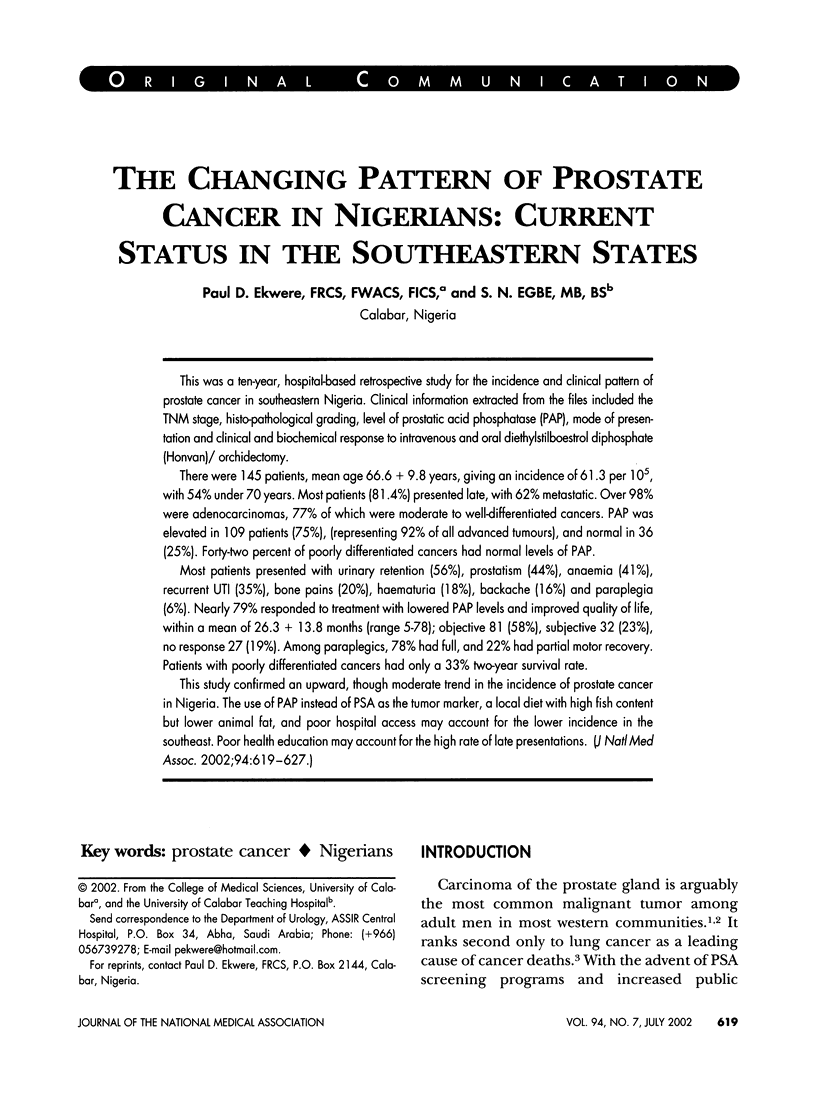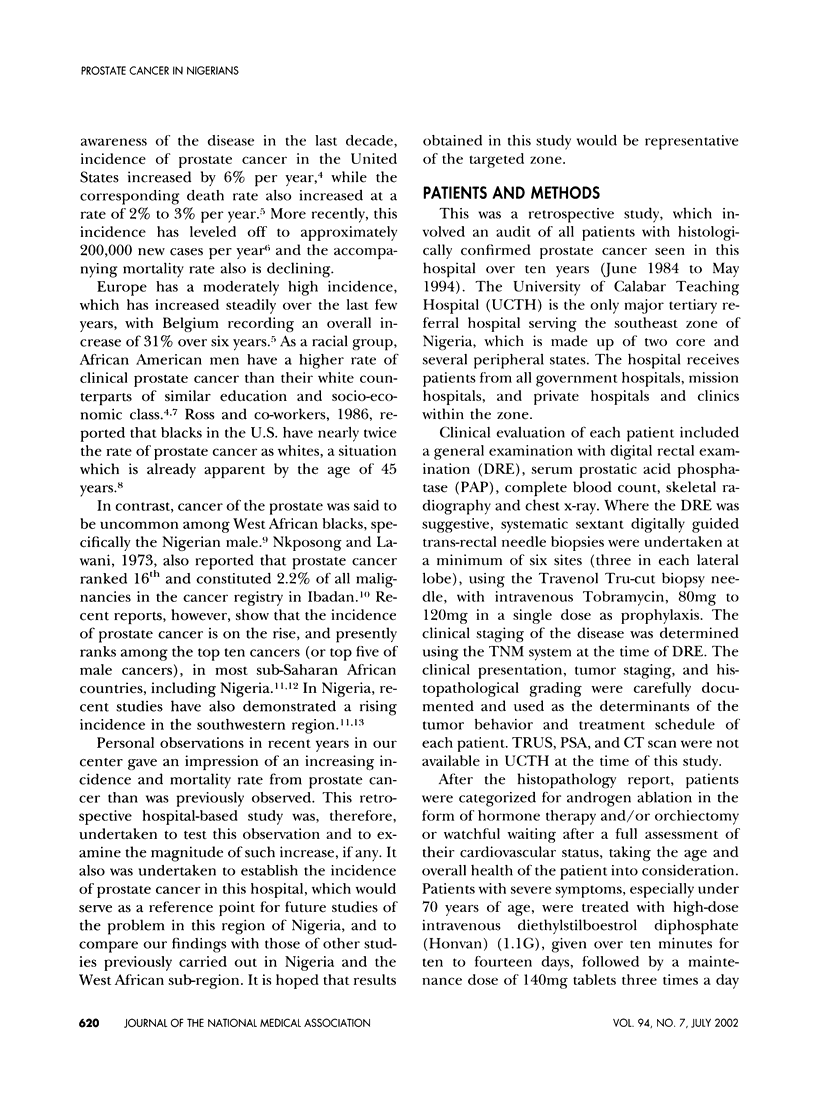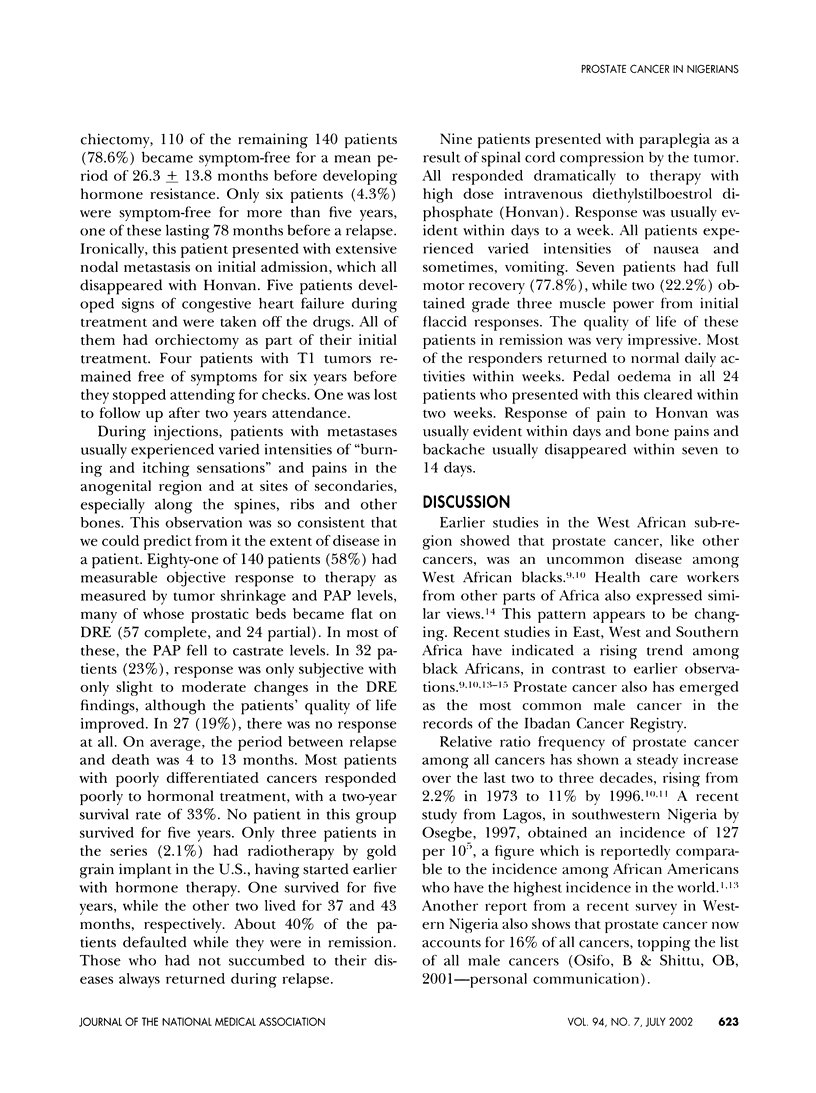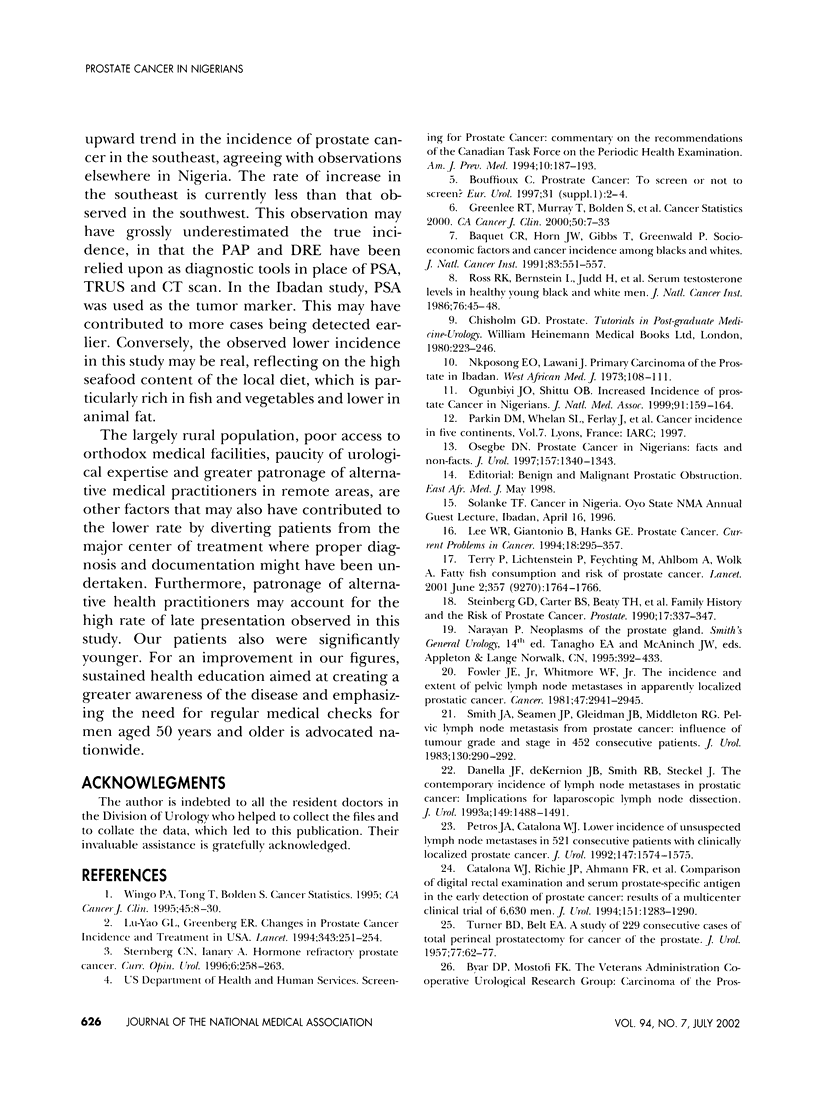Abstract
This was a ten-year, hospital-based retrospective study for the incidence and clinical pattern of prostate cancer in southeastern Nigeria. Clinical information extracted from the files included the TNM stage, histo-pathological grading, level of prostatic acid phosphatase (PAP), mode of presentation and clinical and biochemical response to intravenous and oral diethylstilboestrol diphosphate (Honvan)/ orchidectomy. There were 145 patients, mean age 66.6 + 9.8 years, giving an incidence of 61.3 per 10(5), with 54% under 70 years. Most patients (81.4%) presented late, with 62% metastatic. Over 98% were adenocarcinomas, 77% of which were moderate to well-differentiated cancers. PAP was elevated in 109 patients (75%), (representing 92% of all advanced tumours), and normal in 36 (25%). Forty-two percent of poorly differentiated cancers had normal levels of PAP. Most patients presented with urinary retention (56%), prostatism (44%), anaemia (41%), recurrent UTI (35%), bone pains (20%), haematuria (18%), backache (16%) and paraplegia (6%). Nearly 79% responded to treatment with lowered PAP levels and improved quality of life, within a mean of 26.3+/-13.8 months (range 5-78); objective 81 (58%), subjective 32 (23%), no response 27 (19%). Among paraplegics, 78% had full, and 22% had partial motor recovery. Patients with poorly differentiated cancers had only a 33% two-year survival rate. This study confirmed an upward, though moderate trend in the incidence of prostate cancer in Nigeria. The use of PAP instead of PSA as the tumor marker, a local diet with high fish content but lower animal fat, and poor hospital access may account for the lower incidence in the southeast. Poor health education may account for the high rate of late presentations.
Full text
PDF








Images in this article
Selected References
These references are in PubMed. This may not be the complete list of references from this article.
- BELT E., TURNER R. D. A study of 229 consecutive cases of total perineal prostatectomy for cancer of the prostate. J Urol. 1957 Jan;77(1):62–77. doi: 10.1016/S0022-5347(17)66523-6. [DOI] [PubMed] [Google Scholar]
- Bahnson R. R., Catalona W. J. Adverse implications of acid phosphatase levels in the upper range of normal. J Urol. 1987 Mar;137(3):427–430. doi: 10.1016/s0022-5347(17)44056-0. [DOI] [PubMed] [Google Scholar]
- Baquet C. R., Horm J. W., Gibbs T., Greenwald P. Socioeconomic factors and cancer incidence among blacks and whites. J Natl Cancer Inst. 1991 Apr 17;83(8):551–557. doi: 10.1093/jnci/83.8.551. [DOI] [PubMed] [Google Scholar]
- Bouffioux C. Prostate cancer: to screen or not to screen? Eur Urol. 1997;31 (Suppl 1):2–4. doi: 10.1159/000474524. [DOI] [PubMed] [Google Scholar]
- Catalona W. J., Richie J. P., Ahmann F. R., Hudson M. A., Scardino P. T., Flanigan R. C., deKernion J. B., Ratliff T. L., Kavoussi L. R., Dalkin B. L. Comparison of digital rectal examination and serum prostate specific antigen in the early detection of prostate cancer: results of a multicenter clinical trial of 6,630 men. J Urol. 1994 May;151(5):1283–1290. doi: 10.1016/s0022-5347(17)35233-3. [DOI] [PubMed] [Google Scholar]
- Danella J. F., deKernion J. B., Smith R. B., Steckel J. The contemporary incidence of lymph node metastases in prostate cancer: implications for laparoscopic lymph node dissection. J Urol. 1993 Jun;149(6):1488–1491. doi: 10.1016/s0022-5347(17)36424-8. [DOI] [PubMed] [Google Scholar]
- Figueiredo A. J., Seeni K., Anson K. M., Furtado A. J., Miller R. A. Are transrectal ultrasonically guided biopsies required for the accurate diagnosis of carcinoma of the prostate? Can digitally guided systematic biopsies offer an acceptable alternative? Br J Urol. 1995 Aug;76(2):187–191. doi: 10.1111/j.1464-410x.1995.tb07672.x. [DOI] [PubMed] [Google Scholar]
- Fowler J. E., Jr, Whitmore W. F., Jr The incidence and extent of pelvic lymph node metastases in apparently localized prostatic cancer. Cancer. 1981 Jun 15;47(12):2941–2945. doi: 10.1002/1097-0142(19810615)47:12<2941::aid-cncr2820471235>3.0.co;2-f. [DOI] [PubMed] [Google Scholar]
- Greenlee R. T., Murray T., Bolden S., Wingo P. A. Cancer statistics, 2000. CA Cancer J Clin. 2000 Jan-Feb;50(1):7–33. doi: 10.3322/canjclin.50.1.7. [DOI] [PubMed] [Google Scholar]
- Heller J. E. Prostatic acid phosphatase: its current clinical status. J Urol. 1987 Jun;137(6):1091–1103. doi: 10.1016/s0022-5347(17)44414-4. [DOI] [PubMed] [Google Scholar]
- Lee W. R., Giantonio B., Hanks G. E. Prostate cancer. Curr Probl Cancer. 1994 Nov-Dec;18(6):295–357. doi: 10.1016/0147-0272(94)90005-1. [DOI] [PubMed] [Google Scholar]
- Lu-Yao G. L., Greenberg E. R. Changes in prostate cancer incidence and treatment in USA. Lancet. 1994 Jan 29;343(8892):251–254. doi: 10.1016/s0140-6736(94)91109-6. [DOI] [PubMed] [Google Scholar]
- McNeal J. E., Bostwick D. G., Kindrachuk R. A., Redwine E. A., Freiha F. S., Stamey T. A. Patterns of progression in prostate cancer. Lancet. 1986 Jan 11;1(8472):60–63. doi: 10.1016/s0140-6736(86)90715-4. [DOI] [PubMed] [Google Scholar]
- Nkposong E. O., Lawani J. Primary carcinoma of the prostate in Ibadan. West Afr Med J Niger Med Dent Pract. 1973 Dec;22(6):108–111. [PubMed] [Google Scholar]
- Oesterling J. E., Brendler C. B., Epstein J. I., Kimball A. W., Jr, Walsh P. C. Correlation of clinical stage, serum prostatic acid phosphatase and preoperative Gleason grade with final pathological stage in 275 patients with clinically localized adenocarcinoma of the prostate. J Urol. 1987 Jul;138(1):92–98. doi: 10.1016/s0022-5347(17)43003-5. [DOI] [PubMed] [Google Scholar]
- Ogunbiyi J. O., Shittu O. B. Increased incidence of prostate cancer in Nigerians. J Natl Med Assoc. 1999 Mar;91(3):159–164. [PMC free article] [PubMed] [Google Scholar]
- Osegbe D. N. Prostate cancer in Nigerians: facts and nonfacts. J Urol. 1997 Apr;157(4):1340–1343. [PubMed] [Google Scholar]
- Partin A. W., Yoo J., Carter H. B., Pearson J. D., Chan D. W., Epstein J. I., Walsh P. C. The use of prostate specific antigen, clinical stage and Gleason score to predict pathological stage in men with localized prostate cancer. J Urol. 1993 Jul;150(1):110–114. doi: 10.1016/s0022-5347(17)35410-1. [DOI] [PubMed] [Google Scholar]
- Petros J. A., Catalona W. J. Lower incidence of unsuspected lymph node metastases in 521 consecutive patients with clinically localized prostate cancer. J Urol. 1992 Jun;147(6):1574–1575. doi: 10.1016/s0022-5347(17)37630-9. [DOI] [PubMed] [Google Scholar]
- Ross R., Bernstein L., Judd H., Hanisch R., Pike M., Henderson B. Serum testosterone levels in healthy young black and white men. J Natl Cancer Inst. 1986 Jan;76(1):45–48. [PubMed] [Google Scholar]
- Smith J. A., Jr, Seaman J. P., Gleidman J. B., Middleton R. G. Pelvic lymph node metastasis from prostatic cancer: influence of tumor grade and stage in 452 consecutive patients. J Urol. 1983 Aug;130(2):290–292. doi: 10.1016/s0022-5347(17)51112-x. [DOI] [PubMed] [Google Scholar]
- Steinberg G. D., Carter B. S., Beaty T. H., Childs B., Walsh P. C. Family history and the risk of prostate cancer. Prostate. 1990;17(4):337–347. doi: 10.1002/pros.2990170409. [DOI] [PubMed] [Google Scholar]
- Terry P., Lichtenstein P., Feychting M., Ahlbom A., Wolk A. Fatty fish consumption and risk of prostate cancer. Lancet. 2001 Jun 2;357(9270):1764–1766. doi: 10.1016/S0140-6736(00)04889-3. [DOI] [PubMed] [Google Scholar]
- Wingo P. A., Tong T., Bolden S. Cancer statistics, 1995. CA Cancer J Clin. 1995 Jan-Feb;45(1):8–30. doi: 10.3322/canjclin.45.1.8. [DOI] [PubMed] [Google Scholar]



